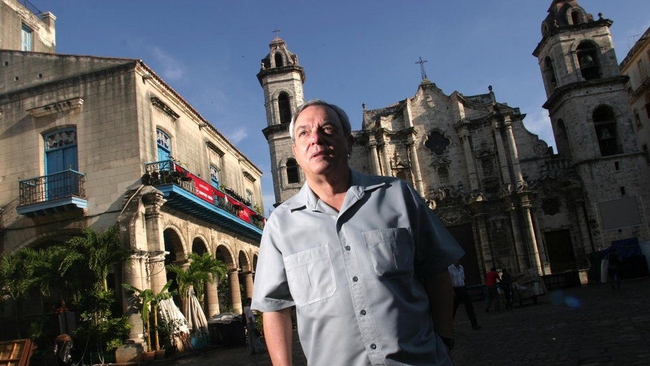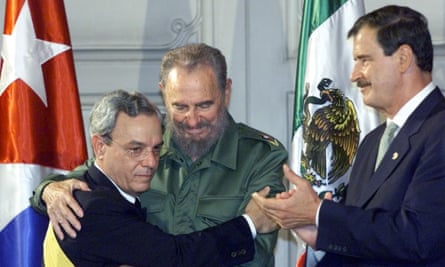The Cuban who saved Havana
News from Cuba | Wednesday, 12 August 2020

Eusebio Leal Spengler, tributed with rescuing the Cuban capitol from decay, died aged 77 in August 2020.
Leal was City Historian of Havana, the ‘City of Columns’, as Cuban writer Alejo Carpentier liked to call it. A Doctor of Historical Sciences (University of Havana), he was a specialist in archaeological science and internationally recognised for his work in preserving the historic character of the Cuban capital.
Born in 1942 and self-educated in his youth, Eusebio Leal was a disciple of Emilio Roig de Leuchsenring, founder of the Office of the Historian of Havana, the leadership of which Leal assumed in 1967.
Leal was also President of the National Monuments Commission, a United Nations Goodwill Ambassador and a member of the unicameral Cuban Parliament. From 1981, he was responsible for the restoration and preservation of the Historic Centre of Havana, a national monument since 1976 and a Heritage for Humanity site since 1982.
In 2019 the Royal Institute of British Architects (RIBA) made him Honorary Associate, an honour bestowed on those considered to have made a particular contribution to architecture. RIBA said that Leal stood out for his “role in creating more sustainable communities, for being involved in their promotion and urban management and nurturing the interests of future generations.”
The mission of the Historianʼs Office is to contribute to the dissemination of Cuban history and culture through “the preservation of material and spiritual symbols and expressions of nationality [... and] the collective historical and cultural memory of the city, especially its Historic Centre,” the largest such colonial centre in Latin America.
Under his leadership, the institution was transformed into an economic and cultural network that includes hotels, restaurants, shops, museums and construction and restoration workshops that are capable of generating the funds necessary to preserve the Historic Centre. The results were spectacular and earned him worldwide fame. More than one hundred old buildings, for the most part complex structures of great historical importance, have been restored under Leal.
It was Leal who managed to get the old town designated a UNESCO world heritage site, and then gather enough money from Europe to start putting the buildings back together.
Describing the process, he said: “The first steps taken were to preserve the architectural heritage that was endangered because of its state of disrepair. But we abandoned the conventional framework, that of preserving monuments, and time has convinced us that there can be no patrimonial development without social and community development as well. We also concluded that development was not possible if we failed to take culture into account. It was important to understand culture as an inspirational value, not in an elitist sense, but in its role as a vanguard of change, of transformation and of research on the past and on the future.”
In the 1990s, Leal convinced Castro of the benefits of setting up a for-profit company that would invest tourist dollars back into the restoration. He started with the Hotel Ambos Mundos, where Hemingway wrote, and then his teams spread out.
Following the collapse of the Soviet Union in 1991 and the advent of the Special Period in Time of Peace, Cuba was plunged into a deep economic crisis. Leal was nonetheless charged with continuing the work of restoring the Historic Centre of the capital, but with severely limited resources. As head of the General Directorate of Cultural Heritage, a new institution created for this purpose, he managed to obtain a certain degree of autonomy from the authorities in the management of the Office of the Historian but only a limited one million dollar budget.
He described the situation in which he found himself: “In October 1994, Fidel Castro offered us a grant of one million dollars, a sum that the Republic was able to afford in these times of crisis. We did not have to repay this contribution, but we were required to invest it in a manner that would make us financially independent. Our work would need to be economically and financially self-supporting. We were granted a legal framework and political support, but we had to achieve financial autonomy. Two years later, in 1996, the initial one million dollars had generated the equivalent of three million dollars in resources. Today, 20 years later, that one million dollars generates revenues 100 times greater. These funds are now used not only to restore our city, but also to provide support to the community, solve problems facing it and integrate it into our project. We shared this revenue with our community by creating a great variety of jobs. We also created schools and workshops to train youth and preserve the heritage and cultural memory of Cuba. We managed to free ourselves from the anxiety created by having bank loans loom over us. We take care of the elderly, the disabled and pregnant women, something no other office of heritage restoration anywhere in the world has done. I think of the restoration of Old Havana as a chapter in the history of the Cuban Revolution.”
Much of the money generated and reinvested into the project comes from tourism, which Leal welcomed, but acknowledged that care needed to be taken not to let it dominate: “We must ensure that Havana does not disappear under a tide of tourists. But, at the same time, I believe that tourism should not be demonised, it is a necessary activity, an important economic factor, and in the case of Cuba – given its isolation – an opportunity also to initiate a direct dialogue with visitors from all regions of the world. Something that seems wonderful to me.”
One of his last projects was the restoration of the Capitolio building which re-opened in 2019 following six years of construction and reparation work. “I believe it will be a jewel of Havana,” he said when it closed for restoration in 2013.
“For decades, he battled to preserve Havana from the ravages of sea-spray, sun and torrential rain,” said BBC Havana correspondent Will Grant, who recalled Leal telling him in 2016 that “when a building collapses anywhere in this city, it takes with it a piece of my heart.”
Leal’s death came after a long illness and state TV interrupted its broadcast to announce his death. The residents of Havana hung white sheets on their balconies in tribute to the man who could regularly be seen wondering the capital’s backstreets and was much loved by Habaneros. Cuba’s president, Miguel Díaz-Canel, described him as “the Cuban who saved Havana”.
He oversaw the celebrations of the city’s 500th anniversary in 2019 and reflected on his love affair with the capital in an interview the same year: “It is true that everything brings me back to Havana. It has been many years of work and commitment which I do not regret. If there were an afterlife, my soul will wander eternally through Havana. It has been the best of my loves, the best of my passions, the greatest of my challenges. I really don’t know why I always return mysteriously to it, in the light and in the silence, in life and in dreams.”








